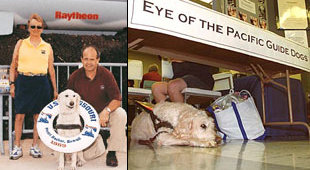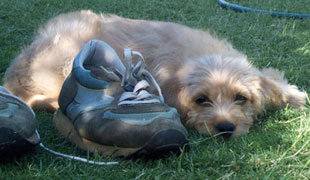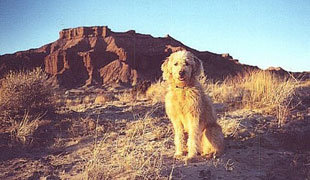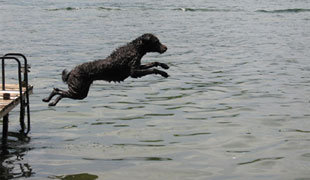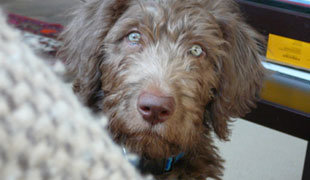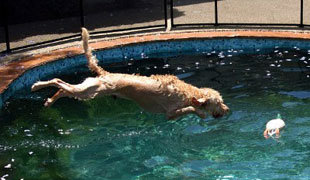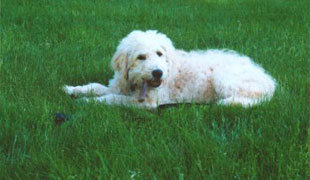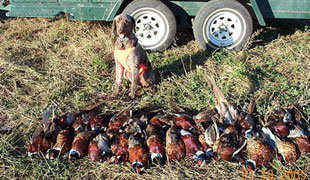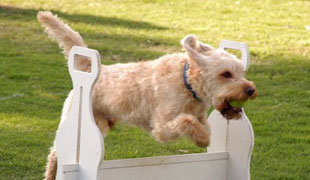
© Copyright Goldendoodles.com 2001. All rights reserved. You may not copy or otherwise use anything on this site without our written permission.
FAQ: LABRADOODLES
Origin
The first deliberately bred Labradoodle was bred by Wally Conron, head breeder for the Australian Guide Dog Association in 1989. The following is an article excerpt by the AGDA - "The story began in 1988 when our manager of Guide Dogs, was in Hawaii on holiday and met Pat Blum... To read more click here * for more details, read Wally's story online - ReadersDigest.com.au * photo: Pat Blum, Sultan and Guide Dog Services manager John Gosling, AGDA Historical Note : Donald Campbell, a British speed record breaker who died in a water speed record attempt in 1969 used the term 'Labradoodle' in his autobiography in 1955. "It was a gloomy job but we had some laughs, many at the expense of my dog, Maxie. I'd had him since he was a pup in 1949 and we call him a "Labradoodle" since he is a mixture of a Labrador and a poodle, all black with thick, curly hair." This quote can be found in his autobiography, Into the Water Barrier, Odhams Press Limited, 1955 on page 125.First pet Labradoodle breeder
Dr. Kate Schoeffel, a geneticist and Veterinarian in Condoblyn, New South Wales, a friend of the AGDA's head breeder Wally Conron, began crossing Miniature Poodles with Labrador Retrievers as family pets around 1991. Kate introduced the miniature Dood to North American Labradoodle & Goldendoodle breeders in 1999. Active on the forums, Kate provided expert guidance and support to the breeders of these new hybrids.Description
The Labradoodle's body is slightly heavier than that of a Standard Poodle. The forelimbs are robust and muscular. The muzzle is slightly narrower than a Labrador Retriever. The length of the coat is anywhere from 4 to 6 inches (10-15 cm.) long. Coat colors include: chalk, cream, apricot, chocolate, café, black and silver. Chalk, cream and apricot/gold can have rose or black pigment. Almost half of all Labradoodles don't shed, or shed lightly, and most live easily with families with MILD allergies. - see Dood DatabaseGenerations
A first generation Labradoodle is the product of a standard Poodle crossed with a Labrador Retriever. About half of all first generation Labradoodles either don't shed or shed lightly, and most are compatible for most families with mild allergies. (source- Dood Database) The backcross (F1b) Labradoodle is produced by crossing an F1 Labradoodle with a Poodle. These dogs will have a higher success rate for non-shedding, and are recommended for families with moderate to severe allergies. Technically a multigeneration Labradoodle should be the product of a Labradoodle crossed with a Labradoodle. However, most multigeneration breeders breed Labradoodles to other Labradoodles, Labradoodle backcrosses, or Poodles. For a more detailed description of the generations - click here For a detailed description of the Australian Labradoodle - click hereTemperament
The Labradoodle is good with children and are easy to train. They get along well with other dogs. They are extremely clever, sociable and well tempered.Height, Weight
A general rule of thumb is to add both the parents weights together and divide by 2 to get an average adult weight on the puppies. Within any litter there may be puppies that fall above or below the projected adult weights. Some Standard sized have grown to over 100 pounds. Standard - predicted to be 45 lbs or more at adulthood. Medium - predicted to be 30-45 lbs at adulthood. Miniature - predicted to be 15-30 lbs at adulthood.Health Concerns
HD, PRA, VonWillebrand's, Elbow and patella disorders.Living Conditions & Exercise
Labradoodles require a moderate amount of exercise and their coats are generally low maintenance. They can live in the city or on a farm. They are social dogs and they are happiest when they are with people.Life Expectancy
About 15 yearsGrooming
First generation Labradoodles tend to have a low maintenance, shaggy dog look, the hair on the body usually about 2 inches long. Labradoodle backcrosses and multigens tend to have longer fur (4 - 7 inches), and require regular grooming.Group
Service dogs, field dogs (top photo courtesy of Cranfield Kennels)




Goldendoodles.com

© Copyright Goldendoodles.com 2001. All rights reserved. You may not
copy or otherwise use anything on this site without our written permission
FAQ:
LABRADOOD
LES
Origin
The first deliberately bred Labradoodle was bred by Wally Conron, head breeder for the Australian Guide Dog Association in 1989. The following is an article excerpt by the AGDA - "The story began in 1988 when our manager of Guide Dogs, was in Hawaii on holiday and met Pat Blum... To read more click here * for more details, read Wally's story online - ReadersDigest.com.au * photo: Pat Blum, Sultan and Guide Dog Services manager John Gosling, AGDA Historical Note : Donald Campbell, a British speed record breaker who died in a water speed record attempt in 1969 used the term 'Labradoodle' in his autobiography in 1955. "It was a gloomy job but we had some laughs, many at the expense of my dog, Maxie. I'd had him since he was a pup in 1949 and we call him a "Labradoodle" since he is a mixture of a Labrador and a poodle, all black with thick, curly hair." This quote can be found in his autobiography, Into the Water Barrier, Odhams Press Limited, 1955 on page 125.First pet Labradoodle
breeder
Dr. Kate Schoeffel, a geneticist and Veterinarian in Condoblyn, New South Wales, a friend of the AGDA's head breeder Wally Conron, began crossing Miniature Poodles with Labrador Retrievers as family pets around 1991. Kate introduced the miniature Dood to North American Labradoodle & Goldendoodle breeders in 1999. Active on the forums, Kate provided expert guidance and support to the breeders of these new hybrids.Description
The Labradoodle's body is slightly heavier than that of a Standard Poodle. The forelimbs are robust and muscular. The muzzle is slightly narrower than a Labrador Retriever. The length of the coat is anywhere from 4 to 6 inches (10-15 cm.) long. Coat colors include: chalk, cream, apricot, chocolate, café, black and silver. Chalk, cream and apricot/gold can have rose or black pigment. Almost half of all Labradoodles don't shed, or shed lightly, and most live easily with families with MILD allergies. - see Dood DatabaseGenerations
A first generation Labradoodle is the product of a standard Poodle crossed with a Labrador Retriever. About half of all first generation Labradoodles either don't shed or shed lightly, and most are compatible for most families with mild allergies. (source- Dood Database) The backcross (F1b) Labradoodle is produced by crossing an F1 Labradoodle with a Poodle. These dogs will have a higher success rate for non-shedding, and are recommended for families with moderate to severe allergies. Technically a multigeneration Labradoodle should be the product of a Labradoodle crossed with a Labradoodle. However, most multigeneration breeders breed Labradoodles to other Labradoodles, Labradoodle backcrosses, or Poodles. For a more detailed description of the generations - click here For a detailed description of the Australian Labradoodle - click hereTemperament
The Labradoodle is good with children and are easy to train. They get along well with other dogs. They are extremely clever, sociable and well tempered.Height, Weight
A general rule of thumb is to add both the parents weights together and divide by 2 to get an average adult weight on the puppies. Within any litter there may be puppies that fall above or below the projected adult weights. Some Standard sized have grown to over 100 pounds. Standard - predicted to be 45 lbs or more at adulthood. Medium - predicted to be 30-45 lbs at adulthood. Miniature - predicted to be 15-30 lbs at adulthood.Health Concerns
HD, PRA, VonWillebrand's, Elbow and patella disorders.Living Conditions &
Exercise
Labradoodles require a moderate amount of exercise and their coats are generally low maintenance. They can live in the city or on a farm. They are social dogs and they are happiest when they are with people.Life Expectancy
About 15 yearsGrooming
First generation Labradoodles tend to have a low maintenance, shaggy dog look, the hair on the body usually about 2 inches long. Labradoodle backcrosses and multigens tend to have longer fur (4 - 7 inches), and require regular grooming.Group
Service dogs, field dogs (top photo courtesy of Cranfield Kennels)




